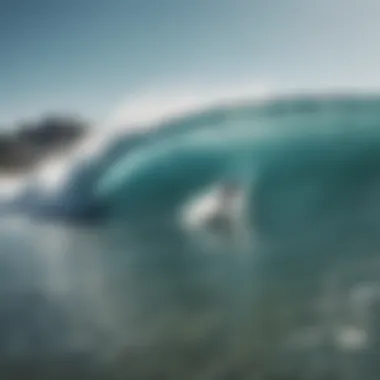Exploring the Wave Pool Experience in Los Angeles


Intro
The beach might come to mind when one thinks of surfing. The smell of salt, the roar of the ocean, and waves crashing around you. But in Los Angeles, a new wave phenomenon is catching attention and reshaping the way enthusiasts approach the sport. Wave pools are changing the surf game, offering a controlled environment where anyone from a rookie to an expert can ride the tide.
To understand the appeal and impact of wave pools, it's essential to look at several key elements. From technological innovations that create perfect waves to their cultural significance in shaping a modern surfing experience, the depth of the wave pool experience is both fascinating and complex. Additionally, the environmental implications of these artificial surfing venues cannot be ignored, as they bring about discussions on sustainability within a region deeply intertwined with its natural coastline.
In this article, we will take a closer look at the intricacies of wave pools in Los Angeles and how they contribute to recreational activities and surfboard culture, often considered a rite of passage for those living in a coastal city.
Understanding Wave Pools
Wave pools have become a focal point in the conversation about modern surfing, particularly in urban areas like Los Angeles. Understanding wave pools is essential for grasping how they impact the surfing culture, lifestyle, and the community itself. They are not just a fad, but an evolution in how surfers and water enthusiasts engage with their passion independently from ocean conditions.
Defining Wave Pools
Wave pools are artificial environments designed to simulate ocean waves, allowing surfers to ride without having to head to the beach. These facilities use advanced technology to generate waves that can mimic various ocean conditions. The uniqueness of a wave pool lies in its ability to create a controlled setting where consistent wave patterns can be produced for surfers of all skill levels. In essence, they provide a training ground where beginners can hone their skills while experienced surfers can perfect their technique.
"Wave pools give surfers a chance to experience the thrill of riding without the unpredictability of the ocean."
Understanding the basic mechanics of a wave pool helps shed light on their allure. Simply put, it's a perfect blend of surf and technology, tailored to meet the needs of a diverse audience.
History of Wave Pools
The inception of wave pools dates back to the early 20th century, though they have gained real traction since the late 1990s and early 2000s. Initially, these pools were seen as mere novelties, experimental in nature, yet they proved to be a promising concept. The first commercial wave pool was built in 1976 in Texas, introducing many to the concept of riding man-made waves.
Since then, advancements in technology have led to the development of more sophisticated systems capable of producing more realistic and varied wave forms. The notion gradually garnered interest and investment, leading to a boom in wave pool facilities across the globe, especially in areas far removed from natural surfing hotspots.
Mechanical Systems Behind Wave Production
The heart of any wave pool lies within its mechanical systems, which enable the generation of waves. Different types of technology are employed, each with its advantages and limitations. The prevalent systems include pneumatic, hydraulic, and mechanical wave generation.
- Pneumatic Systems: These use compressed air to create waves. They are versatile but often expensive to maintain.
- Hydraulic Systems: Utilizing water pressure to produce waves, these systems tend to create larger waves but may require significant energy.
- Mechanical Systems: Often simpler, these systems utilize moving parts to push water and create waves.
Understanding these mechanical aspects not only sheds light on how wave pools function but also can guide future innovations. As technology continues to evolve, the efficiency of these systems may enhance, offering even more realistic surfing conditions in controlled environments.
The integration of such technology in wave pools ultimately broadens the horizons of surfing, making the sport accessible for those who may not have the opportunity to visit the ocean regularly.
Wave Pool Culture in Los Angeles
The wave pool scene in Los Angeles is not just a recreational pastime; it's become an evolving subculture that blends art, sport, and communal vibes. Here, the surf culture morphs greatly, accommodating those who live far from the traditional ocean waves. This change calls attention to the creativity and innovative spirit that Los Angeles cherishes. For surfers, outdoor enthusiasts, and even casual beachgoers, wave pools serve as an inviting alternative for soaking up the sun while riding artificial waves. The space becomes not just a destination but a social hub for like-minded individuals.
The Rise of Wave Pools in Urban Areas
Urban areas across the globe, especially in cities like Los Angeles, see wave pools sprouting up faster than weeds in a garden. The influx of these facilities is driven by the desire for safe surfing conditions and accessibility. With traditional surfing spots sometimes being over-crowded, wave pools offer a manageable environment where learning the sport is simplified.
As city populations increase, the need for recreational spaces becomes ever more crucial. Wave pools are cleverly designed to mimic ocean waves, which provides a real surfing experience, right in the heart of the city. For example, facilities like the NLand Surf Park in nearby Austin have paved the way, demonstrating that an artificial surf experience can replicate the thrill of the sea. Consequently, locals can enjoy a taste of coastal culture without the long drive to the beach, squeezing in a quick surf session after work.
Community and Connection Among Surfers
One specific beauty of wave pools lies in their ability to forge connections between surfers. The communal aspect of these facilities cannot be understated. Regular attendees often develop relationships, where encouragement is shared, tips are exchanged, and camaraderie thrives. It’s much like the neighborhood bar where everyone knows each other's names but with surfboards.
Inventions of programs catering to various skill levels, including kids and beginners, form a welcoming atmosphere that fosters growth. Surfers collaborating at a wave pool can make an extraordinary difference in developing their skills—there's just something about having a friendly face cheering from the sidelines that boosts confidence.
"In wave pools, it's not just about the ride; it's about who you're riding with. You share the waves, the laughs, and sometimes your board too!"


Events and Competitions in Wave Pools
Beyond just casual surfing, competitions held in wave pools are gaining traction, attracting local talent and professional surfers alike. These events allow surfers to showcase their skills in a controlled environment, featuring consistent wave settings—a luxury traditional surfing can rarely offer. You might find, for example, contests organized by facilities like Surf Ranch in Lemoore, which have raised the bar for competitive surfing.
Such competitions are often accompanied by festivals that lift the overall atmosphere, buzzing with energy similar to that of a concert or sporting event. Social media buzz often follows these gatherings as friends and families come to witness talent and cheer on the participants. This creates a vibrant surf culture deeply embedded in Los Angeles, showcasing that wave pools are not only functional but also a lively platform for celebration and unity among water sport enthusiasts.
In summary, the culture surrounding wave pools in Los Angeles is multifaceted; it offers an appealing blend of recreation, community-building, and competition. As these wave-solving venues continue to gain popularity, they will undoubtedly deepen their roots in the fabric of urban surf culture.
Key Wave Pools in Los Angeles
Wave pools in Los Angeles are not just venues; they are vital components of the surfing fabric in a city that’s synonymous with sun, surf, and lifestyle. These pools offer a unique environment for both seasoned surfers and newbies alike, providing controlled conditions that promote skill development and enjoyment. With their ability to generate consistent waves, wave pools attract not only local enthusiasts but also travelers looking for a piece of surf culture. Their impact on local economies, surf culture, and community interactions is profound.
Overview of Major Facilities
Los Angeles boasts some of the most innovative wave pools, each with its own flair and offerings. The major players include:
- The Wave: Located in the heart of Los Angeles, it’s renowned for its variety of wave types suitable for surfers of all levels. This facility prioritizes inclusivity and accessibility, encouraging a mixed surf culture.
- Surf Ranch: A bit further afield, this is where wave technology meets luxury. Known for its perfect barrel waves, it serves both competitive surfers and those looking to refine their skills in a one-of-a-kind setting.
- NLand Surf Park: While technically in Texas, it draws many Angelenos. It utilizes a state-of-the-art wave generation technology, leading to consistent and powerful waves.
Each facility not only provides waves but also hosts events, surf classes, and competitions, creating vibrant community hubs.
Comparative Analysis of Wave Pools
When diving into the nitty-gritty, the differences between these wave pools become more apparent. Here’s how they stack up:
- Wave Technology: Some pools, like The Wave, use pneumatic systems, while others, such as Surf Ranch, employ systems that mimic ocean conditions far more closely, hence attracting different kinds of surfers.
- Accessibility: While The Wave is quite centrally located, it may be more crowded compared to Surf Ranch, which is a destination in its own right and thus may have fewer daily visitors.
- Facilities and Services: Amenities vary from pool to pool. Some offer high-end services, including private lessons and coaching, while others focus on community outreach.
These factors greatly influence a surfer’s experience, making it essential to choose the right venue based on personal preferences and skill levels.
Unique Features of Individual Pools
Each wave pool in Los Angeles is a reflection of unique design philosophies and user experiences. For example:
- The Wave features customizable wave profiles, allowing surfers to choose their preferred conditions.
- Surf Ranch offers private cabanas for relaxation between rides, blending comfort with cutting-edge surfing technology.
- NLand Surf Park, though outside LA, offers a natural setting with surrounding amenities that invite groups or families looking to enjoy a full day.
"The best thing about wave pools is that they bring the ocean to us, making surfing easier and more accessible than ever before.”
In exploring the key wave pools of Los Angeles, we identify not just surf spots but community centers, learning environments, and economic contributors. This variety enriches the surfing culture, ensuring that wave pools will continue to play an instrumental role in shaping the future of urban surfing.
Environmental Considerations
The discussion around wave pools extends beyond the thrill of surfing artificial waves; it brings forth vital environmental considerations. These facilities often spark debates about resource utilization and their ecological footprint. By focusing on the environmental aspects, we can appreciate the balance which needs to be maintained between recreation and sustainability, especially in a place like Los Angeles, where water conservation is a pressing issue.
Water Management and Sustainability
Water management plays a crucial role in the operation of wave pools. These venues must tackle the challenge of maintaining optimal water levels while being mindful of local constraints. For instance, the facilities often employ advanced filtration systems to recycle water, significantly reducing the need for fresh sources. This approach is particularly important in a city like Los Angeles, which faces periodic droughts.
Some wave pools even harness renewable energy sources to operate their pumps and filtration systems. Utilizing solar energy or wind power not only helps reduce operational costs but also lessens the overall carbon footprint of the wave pool. By adopting such practices, these venues can serve as models for sustainability, demonstrating how recreational hotspots can innovate in resource management.
Impact on Local Ecosystems
The introduction of wave pools can bring about notable effects on local ecosystems. The construction and operation of these attractions must be approached with caution, as they can disrupt existing habitats. It is essential to consider the consequences, like changes in water temperature and flow patterns, that could affect local wildlife.
Many wave pool operators are becoming increasingly aware of this responsibility, implementing studies to monitor local ecosystems before and after the installation. This proactive approach ensures that measures are taken to minimize any adverse impacts. By engaging environmental scientists, operators can tailor strategies that protect local flora and fauna, thus fostering a harmonious coexistence between industry and nature.


Community Involvement in Conservation Efforts
Community involvement is pivotal in promoting conservation efforts within the realm of wave pools. Many local surfers, environmental activists, and residents take an active role in supporting sustainability initiatives. Events such as beach clean-ups and awareness campaigns often arise, driven by the shared interest in protecting local ecosystems and educating the public about the importance of environmental stewardship.
These efforts can create a unified front, advocating for responsible practices in both surfing and facility management. Collaboration with local schools and organizations can further enhance these initiatives, ensuring that the message of conservation reaches a wider audience. When surfing enthusiasts engage in such activities, they not only contribute positively to their environment but also strengthen their community ties.
"Wave pools do more than just provide waves; they have the potential to create a community that cares for its environment."
Integrating these environmental considerations into the broader discussion about wave pools in Los Angeles helps create a comprehensive narrative that values sustainability, ecological balance, and community engagement.
Technological Innovations in Wave Pools
The technological advancements in wave pools have reshaped how we perceive surfing, especially in a city like Los Angeles, where the surfing culture runs deep within the community. This chapter dives into the cutting-edge systems that produce artificial waves, their impact on the surfing experience, and how they play into the broader narrative of urban recreation.
Advances in Wave Generation Technology
Wave generation technology has come a long way since the early days of simple mechanical setups; now, systems like the Wavegarden and Kelly Slater Wave Company utilize advanced hydraulics and pumps to deliver a spectrum of wave types. These technologies allow for personalized experiences—some can mimic the gentle waves of a beach, ideal for beginners, while others create barreling waves that challenge even seasoned surfers. The precision in wave design means surfers can practice their skills in a controlled environment, leading to faster progression and skill development.
Moreover, the versatility of these systems means various wave sizes can be generated at different times, accommodating everyone from tourists looking to catch their first wave to competitive surfers preparing for contests. This adaptability has transformed wave pools from simple recreational spots into high-tech training grounds.
Key points of wave generation technology include:
- Customizable wave patterns for individual needs.
- Enhanced safety features reducing the likelihood of injuries.
- Integration of surfing lessons with real-time performance tracking.
Future Trends in Wave Pool Development
As the surfing community leans into innovation, the future of wave pool development is ripe with possibilities. It seems likely that more wave pools will incorporate eco-friendly systems that not only save water but also engage in energy recovery through solar power or other renewable means. Imagine a wave pool that is self-sustaining, creating waves while also contributing positively to the environment around it.
Additionally, smart technology is likely to make waves—quite literally. IoT devices could track conditions related to temperature, wave sizes, and even user preferences, creating personalized surfer experiences like never before. The ability to tap into data analytics may refine the way we recreate and compete, benefiting both casual surfers and professionals alike.
"Wave pools are not just about the waves; they’re the epicenter of innovation where surf culture thrives amid technology.”
Integration with Surfboard Technology
The evolution in wave generation has naturally led to advances in surfboard technology as well. Manufacturers are now designing boards specifically made for the unique features of artificial waves. These boards often come with adjustable fins and lightweight materials to optimize performance.
Surfers are seeing a rise in new materials like carbon fiber which not only enhances the board's resilience but also improves maneuverability. Some tech-savvy brands are even experimenting with smart boards. These boards can fit sensors that provide feedback on various metrics, allowing surfers to track their performance and make necessary adjustments.
As we look at this technological landscape, the intertwining of surfing and tech heralds a new era for wave pools, ushering a vibrant and dynamic surfing culture right in the heart of urban settings like Los Angeles.
Economic Impact of Wave Pools
The emergence of wave pools has changed the game not just for surfers but also for the local economy in Los Angeles. These innovative water facilities aren’t just a spot for fun; they’re a driving force behind urban economic dynamics. By examining the financial opportunities they present, we can understand their broader societal effects. This section digs deep into how wave pools contribute to revenue generation, job creation, and investment trends, crafting a fuller picture for our discerning audience.
Revenue Generation and Local Business Growth
Wave pools contribute significantly to local economies by attracting a diverse crowd. Families looking for recreational activities, surfers honing their skills, and tourists eager for new experiences flock to these pools, leading to increased foot traffic in nearby businesses.
- Increased Sales: Retail shops selling surf gear, snacks, and beverages see a noticeable uptick in customer numbers on wave pool days. People often grab a quick bite or final touches on their surf setup before hitting the water.
- Tourism Boost: Wave pools drawing visitors from outside the region generate additional revenue through hotel stays, dining, and local attractions. The vibe of enjoying the waves in an urban setting creates a fresh allure for tourists, complementing traditional beach offerings.
- Event Hosting: Many wave pools host various events, from competitions to festivals. These events help organize major gatherings that can fill hotels and restaurants. They provide a platform for local businesses to display their products or services, leading to collaborative marketing strategies that drive revenue higher.
All these factors contribute to a vibrant local economy, proving that wave pools are quite a catch for communities.
Job Creation in the Surf Industry


As wave pools thrive, they create a ripple effect in the job market, particularly in the surf industry. These facilities require a dedicated workforce to operate, maintain, and manage the experiences offered to guests.
- Employment Opportunities: From lifeguards to instructiors and facility management roles, wave pools generate a diverse range of jobs. As more venues pop up in LA, the demand for these positions continues to rise.
- Skills Development: Many pools offer training programs for job candidates and surfers. This fosters skill development in coaching, safety, and maintenance practices, enhancing the workforce's capabilities and potential.
- Support for Local Talent: As the interest in surfing grows, surf brands and equipment manufacturers have more reasons to invest in local talent. This can lead to sponsorships, collaborations, and community-building initiatives that buckle into economic support for aspiring athletes and business-minded individuals.
Investment Trends in Urban Surfing Venues
The investments flowing into wave pools highlight the trend of integrating surfing into city life. By examining where the money is going, we can uncover the motivations behind these ventures and potential future developments.
- Public and Private Funding: Urban wave pools often see financial backing from both public and private sectors. City governments may see the potential for tax revenue, enhanced leisure facilities, and public health benefits, while private investors recognize opportunities for profit in a growing market.
- Expansion Plans: As popularity escalates, existing venues may expand their facilities or upgrade their technology to stay competitive. This fosters continual investment in the sector, making way for innovations that keep the surfing experience fresh and exciting.
- Long-term Viability: Investors are recognizing that surfing, especially within urban environments, isn't just a passing trend. The commitment seen in new developments signals a robust belief in the sustaining power of wave pools as not just entertainment but also a significant part of urban culture.
Ultimately, the economic impact of wave pools is far reaching, shaping both the local landscape and contributing to the broader surfing community. By creating jobs, enhancing local businesses, and attracting investment, these facilities are more than just waves—they are an economic tide uplifting Los Angeles.
Personal Experiences in Wave Pools
The allure of wave pools in Los Angeles isn't just in the artificial waves themselves; it's deeply rooted in the personal experiences of those who frequent them. Understanding these experiences gives us insights into what makes wave pools not just a place to surf, but a community hub, a space for growth, and sometimes, a battleground of sorts. For many surfers, both seasoned and novices, personal experiences shape their passion for the sport. It is these narratives that connect individuals to the culture of surfing and provide value well beyond mere recreation.
Testimonials from Frequent Visitors
Hearing from those who ride the waves in these pools often brings to light the varying individual journeys. Frequent visitors often share compelling stories, ranging from a simple love for the ocean to transformational experiences that push their limits.
- "It's like riding a wave from my dreams!" says Jamie, a local surfer who visits the wave pools every weekend.
- "Honestly, I felt like I was catching my first wave all over again, each time I show up!" echoes Marco, who reflects on the excitement that keeps bringing him back.
Testimonials highlight the pools as a sanctuary for adventure seekers. The familiarity of the waves brings them a sense of comfort while also providing an environment to experiment with new techniques. Visitors often rave about the steady setting, allowing them to polish their skills without the unpredictability of the open sea.
"These pools allow us to focus on form and technique, breaking bad habits before they take root. It's like having infinite tries until we get it right," notes Angela, a surf coach who trains her students in the wave pools.
Skill Development Opportunities
Wave pools not only provide a place for fun, they also serve as excellent arenas for skill development. The reliability of wave height and intervals sets a perfect stage for surfers wanting to refine their techniques or learn new skills without the fear of being tossed off a wild wave.
- Progressive Learning: Surfers can start with gentle waves and gradually tackle more challenging ones as they become more confident. This helps build up their skills systematically.
- Structured Lessons: Many wave pools offer classes with instructors. This structured environment combined with instant feedback accelerates learning.
- Safety and Support: With trained staff on-site, beginners can practice without the more hazardous elements present in ocean surfing, making it a nurturing ground for competence.
For both instructors and students, the pool becomes a collaborative environment. Coaches utilize the setting to analyze students’ performances and provide tangible, actionable feedback immediately after each run.
Challenges Faced by Surfers
While the wave pool experience is mostly positive, challenges do linger. Not everything is smooth sailing; many surfers face unique hurdles that can influence their overall enjoyment and growth.
- Wave Consistency: While the pools promise predictable waves, sometimes the machine's malfunction or maintenance issues can disappoint eager surfers.
- Repetitiveness: Some surfers argue that riding the same type of wave can get mundane over time. For thrill-seekers, this might become a breeding ground for boredom.
- Camaraderie vs. Competition: As neighborhoods gear up to attract surfers, the friendly vibe can occasionally cross into competitive territory, causing tensions among both groups. This dynamic can affect the communal aspect that many cherish about surfing culture.
Ultimately, the journey through these challenges adds layers to the personal narrative of each surfer. Whether it’s overcoming the frustration of a missed wave or the exhilaration of finally executing that new trick, every experience is a stepping stone in their surf journey.
The Future of Surf Culture in Urban Settings
The landscape of surf culture is morphing as urban settings incorporate more facilities that emulate the ocean's dynamic environment. As wave pools become a staple in cities, particularly in Los Angeles, the dialogue around surfing undergoes a notable shift. This transformation not only influences recreational practices but also brings to light the diverse relationships between humans and water-based activities.
Potential Growth of Wave Pools
One cannot overlook the significant potential for growth that wave pools present in urban environments. As more people flock to cities, the demand for activities that forge connections to nature and promote physical fitness is on the rise. Wave pools provide an abundance of opportunities for this, appealing to spontaneous visitors as well as serious surfers seeking to refine their skills.
- Accessibility: Urban wave pools can make surfing accessible to those who might not live near the coast. This creates a new generation of surfers who can practice year-round, regardless of weather conditions or ocean tides.
- Community Building: Wave pools can foster a sense of community among surfers, individuals who may have felt disconnected from the traditional surf culture focused heavily on coastal living. These spaces can serve not just as venues for sport but also as gathering spots for enthusiasts to share experiences and techniques.
Moreover, as wave technology continues to evolve, pools are becoming more efficient and versatile, allowing for a variety of wave types. This adaptability can cater to a range of skill levels, from beginners trying to stand on a board for the first time to seasoned surfers honing their tricks and maneuvers.
Emerging Trends in Urban Surfing
The burgeoning trend of urban surfing reflects broader cultural currents, which are worth exploring. Because cities are becoming more aware of environmental impacts, many of these facilities are designed with sustainability in mind. This focus could profoundly affect how we view surf culture, integrating a more conscious approach to leisure.
- Sustainable Practices: Many urban wave pools are implementing water recycling systems and employing alternative energy sources to lessen environmental footprints. For example, utilizing solar panels to power wave generation systems could become increasingly common, marrying surfing with eco-friendliness.
- Cultural Integration: The rise of wave pools in urban areas invites engagement from various cultural facets, like art and music. Festivals and events can celebrate local talent alongside surfing competitions, broadening the appeal of surfing beyond just the act itself.
- Technological Evolution: Innovations in wave generation and surfboarding technology may continue to redefine experiences in wave pools. With advancements such as smart surfboards that connect to apps for performance tracking, surfers can tailor their practices more efficiently.
As urban environments embrace the surf culture, new doors open—changing who can ride the waves and how the culture evolves.



